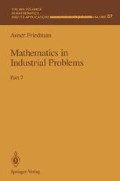Abstract
Data fusion is concerned with the following general problem: Locate and identify objects of many different types on the basis of different kinds of evidence. The evidence is collected on an ongoing basis by many sensors having varying capabilities. Some evidence might be (i) probabilistic, e.g., estimated location with Gaussian distribution supplied by radar, (ii) incomplete probabilistic, e.g., partially specified location distribution supplied by sonar, (iii) linguistic, e.g., sighting by pilot (“sub is probably in region A but may also have been in region B”), (iv) conditional, e.g., if A is observed then B is observed with probability p(B∣A),etc.
Access this chapter
Tax calculation will be finalised at checkout
Purchases are for personal use only
Preview
Unable to display preview. Download preview PDF.
References
A. Friedman, Mathematics in Industrial Problems, Part 6, IMA Volume 57, Springer—Verlag, New York (1993).
R. Mahler, Global integrated data fusion,Proceedings of the Seventh National Symposium on Sensor Fusion, Sandia National Laboratories, Albuquerque, March 16–18 (1994), to appear.
G. Matheron, Random Sets and Integral Geometry, John Wiley, New York (1975).
K. Hestir, H.T. Nguyen, and G.S. Rogers,A random set formalism for evidential reasoning, in I.R. Goodman, M.M. Gupta, H.T. Nguyen and G.S. Rogers, editors, Conditional Logic in Expert Systems, North-Holland, Amsterdam, 1991, pp. 309–344.
E.J. Dudewicz and S.N. Mishra, Modern Mathematical Statistics, John Wiley Si Sons, New York (1988).
H.L. Van Trees, Detection, Estimation, and Modulation Theory, Part I: Detection, Estimation and Linear Modulation Theory, John Wiley & Sons, New York (1968).
G.E. Shilov and B.L. Gurevich, Measure, and Derivative: A Unified Approach, Prentice-Hall, Englewood Cliffs, N.J. (1966).
Author information
Authors and Affiliations
Rights and permissions
Copyright information
© 1995 Springer-Verlag New York, Inc.
About this chapter
Cite this chapter
Friedman, A. (1995). Finite set statistics with applications to data fusion. In: Mathematics in Industrial Problems. The IMA Volumes in Mathematics and its Applications, vol 67. Springer, New York, NY. https://doi.org/10.1007/978-1-4613-8454-0_17
Download citation
DOI: https://doi.org/10.1007/978-1-4613-8454-0_17
Publisher Name: Springer, New York, NY
Print ISBN: 978-1-4613-8456-4
Online ISBN: 978-1-4613-8454-0
eBook Packages: Springer Book Archive

